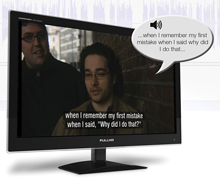Broadcast News
04/10/2013
Improving Accessibility: The Emergence Of Spoken Subtitles

The provision of subtitled broadcast content to provide an increased level of accessibility for the hearing impaired is at a very good level in the UK, US and in many European countries. Now, explains Screen CTO Simon Hailes, the focus is moving towards improved accessibility for the partially sighted.
Traditionally in the UK, accessibility for the partially sighted is provided in the form of Audio Description (AD) where visual cues within the video such as a physical position of a character or prop are verbally described. These audio descriptions are then accessed via a feature of the consumer’s decoder or premixed with a normal stereo track and broadcast as an alternative feed.
Audio Description has certainly made more content accessible to the blind and partially sighted but any programming that has been subtitled for translation purposes has remained out of reach to this portion of society.
In this case then, the use of spoken subtitles, performed by using Text To Speech (TTS), may just plug that particular accessibility gap.
As is true with any business though, the economics of providing a service to a minority group has to be considered, and with the partially sighted audience being approximately 3.3% of the population – with 90% of those over 65 years old – however important the demographic is, the provision of such services has to be cost-effective in order to be widely adopted. Often in cases like this the provision of these types of services needs to be mandated.
Interestingly, an observation that may strengthen the implementation of such audio services is that spoken subtitles may also benefit the dyslexic consumer with the British Dyslexia Society citing that 10% of the UK population are dyslexic with 4% being severely so2.
So, is text-to-speech suitable for Audio Description content? Relevant research suggests that it is, indicating that the majority of AD users would be happy with TTS for audio description if it leads to more AD provision.
In an environment, therefore, where AD provision is being mandated for more broadcasters and for a greater percentage of content, the economics may demand that TTS is used for channels with lower viewing figures.
Spoken Subtitle Provision
Unlike Audio Description, Spoken Subtitles are traditionally provisioned using Text to Speech simply because the textual data is already available in the form of subtitle files. Adding machine-reading, therefore, poses less of an operational challenge.
Currently, the TTS of subtitles is performed in a number of different ways having been developed independently by different national broadcasters.
These vary from decoding Teletext in a PC environment and reading the subtitles directly, to sending a text feed to a centralised server where the audio is produced prior to internet distribution to specialised decoders.
In any case, the original spoken audio (in its native language) is usually still audible so as to convey ‘hint’ information such as the mood and gender of the speaker. This reduces or indeed can eliminate the need for this kind of information having to be included in the TTS feed.
Screen’s Polistream Implementation For Spoken Subtitles
The new implementation in Screen’s Polistream subtitle transmission system consists of an output driver which connects to the channel server in the same way as all other output drivers.
The specialist Polistream module receives ‘subtitles’ and renders them to produce an audio snippet. If the subtitles are timed (i.e. playout), conditions are in place to modify the snippet if it is too long or queued behind more than four seconds of existing audio data.
As the audio data is presented for playout, it is either duplicated into both channels of the stereo pair, or the right track is filled with the AD control data indicating the fade and pan values for the snippet. These are set to configured defaults, or drawn from metadata in the subtitle if present.
The voices are specifically rendered at their native sample rate and converted to 48kHz for output to any Windows sound device.
Screen has selected a card with eight stereo pair AES-EBU outputs, which may be synchronised to a ‘world clock’ signal or to an incoming AES-EBU signal. Alternative delivery can be facilitated by simple integration with internet radio servers, for example IceCast, using virtual audio cables.
‘Live’ subtitles can equally well be rendered using the module, but in this case, the duration is unknown ahead of time, so there is no rate modification.
Provision for file-based workflows has also been considered, with a specialist module being made available for Screen’s offline processing framework MediaMate.
www.screensystems.tv
(IT/CD)
Traditionally in the UK, accessibility for the partially sighted is provided in the form of Audio Description (AD) where visual cues within the video such as a physical position of a character or prop are verbally described. These audio descriptions are then accessed via a feature of the consumer’s decoder or premixed with a normal stereo track and broadcast as an alternative feed.
Audio Description has certainly made more content accessible to the blind and partially sighted but any programming that has been subtitled for translation purposes has remained out of reach to this portion of society.
In this case then, the use of spoken subtitles, performed by using Text To Speech (TTS), may just plug that particular accessibility gap.
As is true with any business though, the economics of providing a service to a minority group has to be considered, and with the partially sighted audience being approximately 3.3% of the population – with 90% of those over 65 years old – however important the demographic is, the provision of such services has to be cost-effective in order to be widely adopted. Often in cases like this the provision of these types of services needs to be mandated.
Interestingly, an observation that may strengthen the implementation of such audio services is that spoken subtitles may also benefit the dyslexic consumer with the British Dyslexia Society citing that 10% of the UK population are dyslexic with 4% being severely so2.
So, is text-to-speech suitable for Audio Description content? Relevant research suggests that it is, indicating that the majority of AD users would be happy with TTS for audio description if it leads to more AD provision.
In an environment, therefore, where AD provision is being mandated for more broadcasters and for a greater percentage of content, the economics may demand that TTS is used for channels with lower viewing figures.
Spoken Subtitle Provision
Unlike Audio Description, Spoken Subtitles are traditionally provisioned using Text to Speech simply because the textual data is already available in the form of subtitle files. Adding machine-reading, therefore, poses less of an operational challenge.
Currently, the TTS of subtitles is performed in a number of different ways having been developed independently by different national broadcasters.
These vary from decoding Teletext in a PC environment and reading the subtitles directly, to sending a text feed to a centralised server where the audio is produced prior to internet distribution to specialised decoders.
In any case, the original spoken audio (in its native language) is usually still audible so as to convey ‘hint’ information such as the mood and gender of the speaker. This reduces or indeed can eliminate the need for this kind of information having to be included in the TTS feed.
Screen’s Polistream Implementation For Spoken Subtitles
The new implementation in Screen’s Polistream subtitle transmission system consists of an output driver which connects to the channel server in the same way as all other output drivers.
The specialist Polistream module receives ‘subtitles’ and renders them to produce an audio snippet. If the subtitles are timed (i.e. playout), conditions are in place to modify the snippet if it is too long or queued behind more than four seconds of existing audio data.
As the audio data is presented for playout, it is either duplicated into both channels of the stereo pair, or the right track is filled with the AD control data indicating the fade and pan values for the snippet. These are set to configured defaults, or drawn from metadata in the subtitle if present.
The voices are specifically rendered at their native sample rate and converted to 48kHz for output to any Windows sound device.
Screen has selected a card with eight stereo pair AES-EBU outputs, which may be synchronised to a ‘world clock’ signal or to an incoming AES-EBU signal. Alternative delivery can be facilitated by simple integration with internet radio servers, for example IceCast, using virtual audio cables.
‘Live’ subtitles can equally well be rendered using the module, but in this case, the duration is unknown ahead of time, so there is no rate modification.
Provision for file-based workflows has also been considered, with a specialist module being made available for Screen’s offline processing framework MediaMate.
www.screensystems.tv
(IT/CD)
Top Related Stories
Click here for the latest broadcast news stories.
15/04/2024
Amagi And AD Digital Launch MAVTV Brasil's FAST Channel
Amag and AD Digital, renowned for its nearly three decades of service and solution integration expertise in the Brazilian market, have unveiled the la
Amagi And AD Digital Launch MAVTV Brasil's FAST Channel
Amag and AD Digital, renowned for its nearly three decades of service and solution integration expertise in the Brazilian market, have unveiled the la
05/06/2014
A Viable Economic Alternative to AD...
Both Spoken Subtitling and Audio Description may be candidate services that could benefit from the application of Text-To-Speech technology, says John
A Viable Economic Alternative to AD...
Both Spoken Subtitling and Audio Description may be candidate services that could benefit from the application of Text-To-Speech technology, says John
20/02/2024
NADiV Audio Introduces Range Of Dante Audio And Control Devices
NADiV Audio has launched its NADiV range of Dante-enabled audio interface and control devices for portable and installed AV and pro audio environments
NADiV Audio Introduces Range Of Dante Audio And Control Devices
NADiV Audio has launched its NADiV range of Dante-enabled audio interface and control devices for portable and installed AV and pro audio environments
28/07/2023
DHD audio Unveils XS3 Core Audio Processor
DHD audio has announced a new addition to its modular range of audio studio equipment and systems. The XS3 core audio processor supports up to 20 ster
DHD audio Unveils XS3 Core Audio Processor
DHD audio has announced a new addition to its modular range of audio studio equipment and systems. The XS3 core audio processor supports up to 20 ster
12/04/2023
Audio-Technica's BP3600 Immersive Audio Microphone Now Available
Audio-Technica has announced scheduled availability in Europe and the UK for its recently launched BP3600 Immersive Audio Microphone. A premium broadc
Audio-Technica's BP3600 Immersive Audio Microphone Now Available
Audio-Technica has announced scheduled availability in Europe and the UK for its recently launched BP3600 Immersive Audio Microphone. A premium broadc
31/03/2023
Digital Audio Denmark Introduces AX Center Thunder|Core Audio Interface
Digital Audio Denmark's new AX Center is a dedicated Thunderbolt modular audio interface with dual mic and instrument inputs, dual headphone and monit
Digital Audio Denmark Introduces AX Center Thunder|Core Audio Interface
Digital Audio Denmark's new AX Center is a dedicated Thunderbolt modular audio interface with dual mic and instrument inputs, dual headphone and monit
22/05/2023
Synthax Audio Appointed Distributor For TIERRA Audio
Synthax Audio UK has been appointed UK and Ireland distributor for TIERRA Audio's range of professional audio products. Founded in 2018 in Madrid, Spa
Synthax Audio Appointed Distributor For TIERRA Audio
Synthax Audio UK has been appointed UK and Ireland distributor for TIERRA Audio's range of professional audio products. Founded in 2018 in Madrid, Spa
17/07/2023
ES-Pro Audio Appointed To Handle Prism Sound's Range Of Audio Converters
Prism Sound has appointed ES-Pro Audio to handle its entire range of audio converters to the professional market in Germany. Formerly a Prism Sound re
ES-Pro Audio Appointed To Handle Prism Sound's Range Of Audio Converters
Prism Sound has appointed ES-Pro Audio to handle its entire range of audio converters to the professional market in Germany. Formerly a Prism Sound re
11/11/2016
What Is The Future For Immersive Audio?
Peter Poers, Managing Director at Jünger Audio, looks at production efforts versus consumer experience. Introduction Along with the evolution of highe
What Is The Future For Immersive Audio?
Peter Poers, Managing Director at Jünger Audio, looks at production efforts versus consumer experience. Introduction Along with the evolution of highe
21/04/2023
Parabolic Deploys Cleanfeed To Re-Record High Qulaity Audio
Audio post production facility Parabolic is using Emmy Award-winning Cleanfeed to re-record high quality audio, in real time, from anyone and from any
Parabolic Deploys Cleanfeed To Re-Record High Qulaity Audio
Audio post production facility Parabolic is using Emmy Award-winning Cleanfeed to re-record high quality audio, in real time, from anyone and from any
21/04/2023
DHD TX2 Ultra-Compact Multitouch Audio Production Mixer To Debut At MPTS
The DHD TX2 ultra-compact multitouch audio production mixer will make its UK exhibition debut at the Media Production & Technology Show (MPTS), Olympi
DHD TX2 Ultra-Compact Multitouch Audio Production Mixer To Debut At MPTS
The DHD TX2 ultra-compact multitouch audio production mixer will make its UK exhibition debut at the Media Production & Technology Show (MPTS), Olympi
20/03/2023
Martin Audio North America To Host Open Day
Martin Audio North America has chosen the Merriweather Post Pavilion in Columbia, Maryland, for its first post-pandemic Open Day on Tuesday, 09 May. T
Martin Audio North America To Host Open Day
Martin Audio North America has chosen the Merriweather Post Pavilion in Columbia, Maryland, for its first post-pandemic Open Day on Tuesday, 09 May. T
15/03/2023
Audio-Technica's ATND1061DAN Ceiling Array Now Certified
Audio-Technica has announced that its ATND1061DAN Ceiling Array is now certified for Microsoft Teams Rooms as part of a Q-SYS system. Audio-Technica p
Audio-Technica's ATND1061DAN Ceiling Array Now Certified
Audio-Technica has announced that its ATND1061DAN Ceiling Array is now certified for Microsoft Teams Rooms as part of a Q-SYS system. Audio-Technica p
14/03/2023
MediaProxy Expands Support For Audio Watermarking Technologies
Mediaproxy has further expanded its support for the audio watermarking technologies employed by global measurement and data analytics company Nielsen.
MediaProxy Expands Support For Audio Watermarking Technologies
Mediaproxy has further expanded its support for the audio watermarking technologies employed by global measurement and data analytics company Nielsen.
13/03/2023
Evertz To Shine A Spotlight On Enhanced Audio
As the iconic Studer Audio brand celebrates its 75th anniversary this year, Evertz will use the NAB 2023 platform to shine a spotlight on enhanced aud
Evertz To Shine A Spotlight On Enhanced Audio
As the iconic Studer Audio brand celebrates its 75th anniversary this year, Evertz will use the NAB 2023 platform to shine a spotlight on enhanced aud















